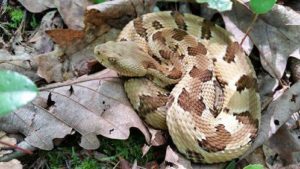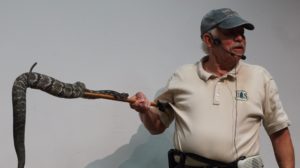Let’s Talk Snakes
Brian Hirt, one of Watoga’s volunteer trail workers had already put a full morning’s work into the Arboretum on Sunday, May 19. Then he decided to finish out the day by continuing his trail marking project on the Allegheny Trail. He had marked several miles of trail when he ran out of trail markers. So he turned around and started back to his car deciding to clear as much debris off of the trail as possible on his return trip.
At one point he reached down, grabbing a large branch, and started to give it a tug when he heard the distinctive and unmistakable sound of a rattlesnake that was hiding under the branch. The rattler did not strike at Brian, nor did Brian provoke the snake, he just walked away. This story has a good ending for both man and snake because Brian did the proper thing when encountering a venomous snake
We humans seem hard-wired to react to snakes and even something that merely resembles a snake. I remember reading an article in a science magazine about a controlled study in which the subjects were exposed to a series of images on a screen, while an fMRI (Functional Magnetic Resonance Imaging) was measuring their brain activity based on blood flow. When body patterns of venomous snakes were shown there was increased blood flow to the amygdala initiating the Fight or Flight Response.
I can relate to this when I remember being startled enough to jump back recently by nothing more than a long, curving section of grapevine lying across the trail. I had reacted physically before my conscious mind confirmed that it was not a snake.
Roy Moose Snakes of West Virginia
Those of you who have attended Roy Moose’s snake program at the Cranberry Mountain Nature Center know that Roy’s level of engagement with the audience is exceptional. He captures the complete attention of adults and children alike. It is somewhat humorous to watch Roy hold forth a garter snake to youngsters who lean forward to accept the snake as the parents simultaneously lean back away from the snake.
Roy’s ever-popular Snakes of West Virginia reveals many facts and misconceptions about the two poisonous snakes found in this region; copperheads and timber rattlesnakes. Roy has been bitten by both species of snake which are pit-vipers. He said that the hand that was bitten swelled up over five times the size of his other hand. And he added that if you are bitten by a poisonous snake you will know it immediately. The pain is horrendous.
He stressed that neither poisonous snake is aggressive; both are exceedingly shy by nature and most people who are bitten were attempting to kill the snake. The best thing to do when you encounter a copperhead or rattlesnake is just to walk away. The strike zone from a coiled position is only half the length of the body. And they can only cover ground at a maximum of five miles per hour so most people could easily outrun a rattler or copperhead.
According to the WVDNR publication Snakes of West Virginia, no one has been killed by a copperhead bite in West Virginia for over 30 years. As for fatalities from rattlesnake bites, from 1969 through 1992 only four people were killed by rattlesnake bites in our state. During the same time period over 15 times more fatalities occurred from bee stings, cows and horses.
Dr. Jennifer Shreves, an emergency room doctor, at the Pocahontas Memorial Hospital, assured me that the facility has a protocol in place for snake bites and anti-venom on hand.
Dr. Shreves emphasized that victims should not bring in the offending snake. Their treatment will be based upon evaluation once they have arrived at the emergency room. This will include a blood test for toxins as the venom from both species of snake are hemotoxins as opposed to neurotoxins.
I asked Dr. Shreves about hikers and trail workers who may be some distance from help. If the victim is alone they should walk slowly back to the nearest help, trying not to get their heart beating any faster than necessary. If the victim has a car nearby they should drive only as far as necessary to get help. If in the company of other people it would be ideal to carry him or her out, however, given the type of terrain in our area that would be extremely difficult at best.
As one ER doctor with experience in treating snakebites puts it, “The most important first aid equipment for a venomous snake bite is a set of car keys.”
As for the toxin, over half of the bites are “dry” bites, meaning that the venom sac is empty. After a copperhead or rattlesnake bites its prey it takes approximately a month to replenish the supply of the toxin. As a side note, if you are bitten you better have good health care insurance; the average cost of an anti-venom treatment is $30,000. It is always better to exhibit smart behavior around snakes than getting treated for a bite.
It wasn’t that awfully long ago that the universal method of treating a bite from a poisonous snake was to simply cut a large X across the wound and suck the venom out, then spitting it on the ground.
With that in mind, I beg your patience in allowing me to share with you a once common tale told around campfires. And in the sort of bars that have singing plastic bass mounted on the wall. And, generally by men.
Humorous Anecdote
As the story goes two friends, Charley and Sam were hiking a section of the Appalachian Trail in the Smokies when Charley took off his pack and headed off into the woods telling Sam he had to go to the bathroom. Charley had just dropped trow and sat down on a log when he felt an excruciating pain that made him howl in agony. Sam yelled, “You OK Charley?” Charley replied, “I’ve been snake bit.”
When Sam got to Charley he asked him where he was bitten; Charley told him that a rattlesnake had bitten him squarely on his derriere. (please note that he actually used another less delicate word to describe that particular area of his anatomy). Charley instructed Sam to run to the little town they hiked through less than a mile back the trail and find a doctor. When Sam got to the town he managed to find a small doctor’s office manned by an elderly doctor. Sam told the doctor that his buddy had been bitten by a rattlesnake about a mile down the trail.
The doctor said, “Where was your friend bitten?” Sam told him the bite was right on his behind. (Sam also used an entirely different word in describing the exact location of the injury). The Doc replied, “Listen, you have to run back as fast as you can and suck all of the venom out of that wound if you want to save your buddy.”
Sam departed immediately and headed back at a fast run. Upon his arrival, Charley was lying upon the ground on his side. In a desperate voice inquired, “What did the doctor say?” To which Sam replied, “He said you’re gonna die.”
With that, I leave you with one more very important thing to do if you see a timber rattler. Please do not harm it. Rather, report it on the West Virginia Department of Natural Resources Rattle Snake Report site. Your participation in this survey will help DNR in managing the timber rattlesnake in the Mountain State.
Ken Springer
1. A special thanks to Dr. Jennifer Shreves and Dr. Michael Jarosick, both ER docs who generously shared information on current treatment modalities for venomous snake bites.
2. Photo of timber rattlesnake courtesy of Rosanna Springston. U.S. Forest Service.
3. Photo of Roy Moose frighteningly close to a rattlesnake, courtesy of me from a safe distance using a telephoto lens.

